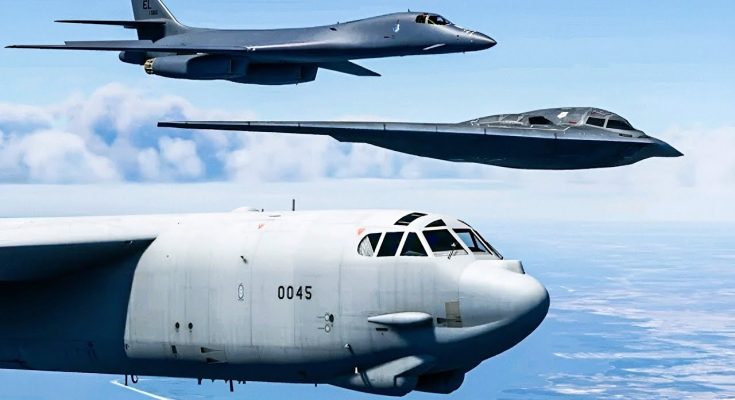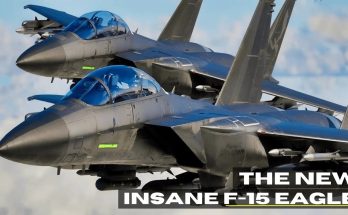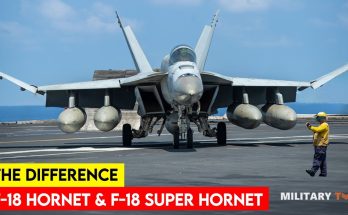Iran on Edge as US Deploys B-2, B-52 & B-1 Bombers Near Its Borders
Tensions in the Middle East have escalated once again as the United States has strategically deployed a formidable array of bombers near Iran’s borders, including the B-2 Spirit, B-52 Stratofortress, and B-1 Lancer. This military maneuver has sparked heightened concern in Tehran, as these bombers represent some of the most powerful assets in the U.S. military’s arsenal. Their presence near Iranian airspace sends a clear and powerful message to the Islamic Republic — that the U.S. remains ready to assert its military dominance and respond decisively to any provocation.
The U.S. Bomber Fleet: A Show of Force
The U.S. Air Force’s bomber fleet is integral to American military strategy, capable of delivering both conventional and nuclear payloads over long distances with unprecedented accuracy and stealth. The three bombers deployed to the region — the B-2 Spirit, B-52 Stratofortress, and B-1 Lancer — each have unique capabilities that make them indispensable in combat situations.
-
B-2 Spirit: The B-2 is a stealth bomber, capable of evading most radar detection systems, making it ideal for penetrating heavily defended airspaces. It can carry a variety of payloads, including precision-guided bombs and nuclear weapons, which makes it a versatile and strategic tool in any conflict.
-
B-52 Stratofortress: The B-52, one of the oldest but most reliable aircraft in the U.S. Air Force, is known for its long-range capabilities and heavy payload capacity. Its versatility allows it to carry both conventional and nuclear weapons, and it has been a key part of America’s nuclear deterrence strategy for decades.
-
B-1 Lancer: The B-1 is a supersonic bomber capable of carrying a wide array of precision-guided munitions. Although it lacks the stealth capabilities of the B-2, its speed and payload capacity make it a formidable asset in conventional warfare scenarios.
The deployment of these bombers near Iran represents a significant escalation of U.S. military posture in the region. It showcases the full spectrum of capabilities that the U.S. can bring to bear in the event of a conflict, from conventional strikes to nuclear deterrence.
Iran’s Reaction: Heightened Tensions and Preparedness
The U.S. bomber deployment has put Iran on high alert, with military officials in Tehran closely monitoring the situation. Given the long-standing animosity between the two nations — exacerbated by the U.S. withdrawal from the Joint Comprehensive Plan of Action (JCPOA) in 2018 — this show of force is likely to be interpreted by Iran as a clear threat to its sovereignty.
In recent years, Iran has invested heavily in its military, developing sophisticated air defense systems like the S-300 and increasingly capable missile systems, such as its Shahab and Sejjil missiles. The deployment of U.S. bombers near Iran’s borders is likely to be seen as a direct challenge to these defense systems. The Islamic Republic may feel pressure to respond either diplomatically or through military means, potentially escalating the situation further.
Iran has also ramped up its own military activities, including missile tests and military drills, in response to perceived threats from the U.S. and its allies in the region. Iran’s strategy has long been to maintain a balance of power in the region through proxy forces and asymmetric warfare, including support for militias and factions in Iraq, Syria, and Yemen. However, direct confrontation with the U.S. military, especially in the face of such overwhelming firepower, remains a dangerous proposition for Tehran.
Strategic Implications for the U.S. and Iran
The U.S. deployment of bombers near Iran’s borders serves multiple strategic purposes. First, it is a clear show of strength, designed to deter any aggressive actions from Iran or its allies in the region. This move is likely aimed at preventing further destabilizing actions, particularly in the Strait of Hormuz, through which a significant portion of global oil shipments pass. Any disruptions to this vital shipping lane could have devastating economic consequences, making the U.S. military’s presence in the region a key factor in maintaining stability.
Second, the U.S. deployment is a form of psychological pressure on the Iranian government. By showcasing its military capabilities, the U.S. seeks to intimidate Iranian leadership into recalibrating its approach to regional security. Whether this will lead to a diplomatic solution or escalate into direct conflict remains uncertain, but the bomber deployments add a layer of complexity to ongoing negotiations over Iran’s nuclear program and regional ambitions.
The Risk of Escalation
While the U.S. bombing fleet is a formidable deterrent, its presence also carries significant risks. The region is highly volatile, and any miscommunication or misstep could easily spiral into a larger conflict. Iran may perceive the U.S. military buildup as an imminent threat, leading to a potential military response. Furthermore, Iran’s alliances with proxy forces in the region could lead to indirect conflict with U.S. interests, potentially drawing the U.S. into a wider confrontation.
Additionally, the presence of such powerful assets near Iranian airspace could provoke an arms race in the region, with Iran continuing to bolster its missile and air defense systems while other regional powers, including Israel and Saudi Arabia, enhance their military capabilities in response.
Conclusion
The deployment of B-2, B-52, and B-1 bombers near Iran’s borders has heightened tensions in the Middle East and placed both the U.S. and Iran on edge. While it serves as a powerful show of force, it also risks triggering an escalation in an already volatile region. For the U.S., the move underscores its commitment to maintaining regional security and deterring Iranian aggression. For Iran, it is a stark reminder of the military imbalance between the two nations and the ever-present threat of confrontation. As both sides navigate these heightened tensions, the world watches closely, aware that the outcome of this standoff could have far-reaching implications for global stability.



